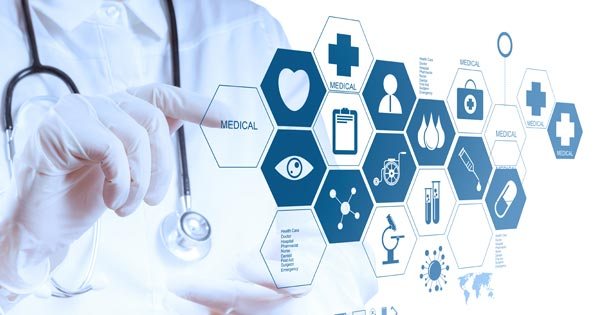A panel of the best doctors and researchers reveals the advances that can transform medical care in 2019
Alternative therapies for pain. Use of artificial intelligence (AI) in health care. Greater opportunity for the treatment of patients with stroke. These are some of the innovations that will improve the healing process and transform medical care next year, according to a distinguished panel of doctors and researchers.
Cleveland Clinic today announced the 10 Best Medical Innovations of 2019 in a multimedia presentation to culminate the 2018 Medical Innovation Summit. Now in its 16th year, the annual Medical Innovation Summit is organized by Cleveland Clinic Innovations, the development, and marketing branch from Cleveland Clinic.
The list of emerging technologies was selected by a panel of doctors and scientists from Cleveland Clinic, led by Michael Roizen, M.D., director of Wellness at Cleveland Clinic.
“Health care is constantly changing, and we anticipate that innovations such as cancer immunotherapy and pharmacogenomics will significantly transform the medical field and improve patient care at Cleveland Clinic and around the world,” said Dr. Roizen.
Next, and in order of anticipated importance, there are the ten best medical innovations of 2019:
1. Alternative therapy for pain: Fight the opioid crisis
The opioid crisis has been declared a public health emergency. Today, chronic pain is the main cause of opioid prescription. Although there are several clinically validated alternative therapies for chronic pain, none have reduced the crisis.
Now, innovation and the potential for hope come from pharmacogenomic tests, which use the genetic makeup of a patient to predict the metabolism of drugs in a person, even if it is an opioid-based drug. Pharmacogenomic tests can be used to avoid adverse reactions and eliminate unnecessary and ineffective prescriptions, replacing them with more effective medications.
Pharmacogenomics can also be used to predict who may have little or no pain relief with some opioid-based pain relievers.
Otherwise, such patients could finish their prescription quickly and return by a new prescription sooner than expected. Pharmacogenomics can reduce or eliminate the stigma of the “drug search” that could be unfairly attributed to such patients and provide the opportunity to adapt to drug therapy.
In 2019, with greater access to genetic testing, pharmacogenomics is ready to make significant advances in precision medicine and potentially end the crisis.
2. The advent of AI in health care
Artificial intelligence, which was once considered a futuristic threat to humanity, is now part of everyday life. In health care, AI is changing the game with its applications to support decisions, for image analysis and classification or triage of patients.
Today, artificial intelligence is helping doctors make smarter decisions at the care site by improving the ease and accuracy of viewing patient tomographs and reducing doctors’ exhaustion.
For example, machine learning algorithms can highlight problem areas in images, thus helping in the selection process and quickly making sense of the mountains of data within the electronic medical record system. With the continuous integration of AI into health care, patient care is no longer a matter of working more, but in a smarter way.
3. Greater opportunity for intervention in cases of acute stroke
When it comes to intervention in a case of stroke, responding on time is critical. Prolonged lack of blood circulation after a stroke can cause irreversible destruction, which often results in disability.
In many cases of stroke, intervention methods can be implemented to save tissue. But so far, intervention in a stroke has only been recommended within a limited period. New guidelines were released last year that suggests a more extended time limit for treatment.
It is anticipated that this long time will reduce the risk of disability and provide the opportunity for recovery to a higher number of future stroke patients.
4. Advances in immunotherapy for cancer treatment
Cancer immunotherapy, or biological therapy, is a technique that uses the body’s immune system to fight cancer. While cancer immunotherapies have been around for some time, extensive work to cure cancer continues to highlight new and novel immunotherapeutic goals.
Scientists are creating new, life-changing cancer treatments through the concepts of joint therapy and manipulation of T lymphocytes. With the almost daily discovery of new immunotherapeutic and biomarker targets, effective therapies for all types of tumors are expected soon.
5. Specific patient products obtained with 3D printers
Using 3D printing technology, medical devices can now adapt to the exact specifications of a patient. Designed to be more compatible with the natural anatomy of an individual, devices modeled from specific patient dimensions have shown that they are better accepted by the body, with results of greater comfort and performance.
The versatility provided by 3D printing gives doctors the possibility of providing patients with the most advanced care while minimizing the risk of complications.
Currently, the most important work in this field includes external prostheses, cranial/orthopedic implants, and tracheobronchial prostheses tailored for diseases that narrow the airways. Work on prostheses and other body implants is also gaining speed, and some have already been authorized for the commercial market.
It has been found that this technology is also useful in surgical planning. To date, the technology has been used for many complicated cardiac surgeries, and even in the most recent total face transplant performed at Cleveland Clinic. With its increasingly broad applications in health care, 3D printing is increasing attention to detail in patient care.
6. Virtual and mixed reality (VR / MR) for medical education
Virtual and mixed reality implies the use of computer technology to create simulated and hybrid environments. Popular for its gaming applications, its virtual and mixed reality, with its futuristic effect, never ceases to dazzle audiences.
But VR / MR technology is much more than a game. These reality systems have recently called the attention of health professionals who want to improve their skills. Now VR / MR programs are popular for medical education, as they provide simulation training to enhance traditional medical education.
With this enveloping learning style, VR / MR training attracts all types of students: audio, visual, and kinesthetic. Education through simulation is a productive step to have the healthiest and safest health care providers in the system.
7. Visor to diagnose strokes before being hospitalized
Although they are less common than ischemic strokes, hemorrhagic strokes – during which blood escapes from a blood vessel that breaks in the brain – are responsible for almost 40 percent of deaths from strokes. Rapid diagnosis is necessary for effective treatment, as uncontrolled bleeding can cause inflammation and damage to the brain. To accelerate the diagnosis, health care professionals are using new and advanced technologies, such as the hemorrhage exploration visor, which can detect bleeding in the brain. The screen for the prehospital examination of hemorrhages is an efficient diagnostic tool that serves to accelerate the diagnosis and the always important moment for treatment.
8. Innovation in robotic surgery
Most of the operations performed today is the shortest and least invasive that science will allow. This adaptation in surgical methodology is partly due to the integration of robotics. Robots in the operating room provide surgeons with guidance for extreme precision in surgery.
Today, surgical platforms are very advanced and are used anywhere, from the spine to endovascular procedures. Less recovery time and less pain after surgery are just some of the benefits observed for the patient with minimally invasive robotic surgery. The continuous advance in this field has led to more precise and useful surgeries with better surgical results.
9. Percutaneous replacement and repair of mitral and tricuspid valves
Cardiac surgery today is less invasive, more routine, and effective than its historical counterpart. Percutaneously, with a catheter through the skin, many cardiac procedures no longer require open-heart surgery. Two of these procedures performed in this way include replacement and repair of the mitral and tricuspid valves.
Stepping on the heels of the percutaneous intervention of the aortic valve, the recent percutaneous intervention of the mitral and tricuspid valves has yielded significant positive results to fill a gap in the field of cardiac surgery.
The exploration of this technology in a larger population of patients is already underway, but with promising postoperative results, innovation has considerable implications for the future of cardiac care.
10. RNA-based therapies
Like DNA-based genetic therapies, RNA-based therapies are the latest innovation in laboratories across the country and have shown immense potential. Interfering with genetic data at the level of ribonucleic acid (RNA) gives scientists the ability to intercept a patient’s genetic abnormality before it translates into functional (or non-functional) proteins.
Today, the most popular and successful mechanisms of RNA therapy include antisense nucleotides and RNA interference. These new therapies are being explored in a variety of rare genetic diseases such as Huntington’s disease, as well as in cancer and neurological diseases, with the hope of treatment through alternative genetic data.
These new mechanisms of action are opening windows for progress and innovation in therapeutics.
U.S. News & World Report ranks Cleveland Clinic as #2 amongst U.S. hospitals





